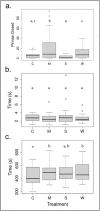Do environmental stimuli modify sensitive plant (Mimosa pudica L.) risk assessment?
- PMID: 38127910
- PMCID: PMC10734946
- DOI: 10.1371/journal.pone.0294971
Do environmental stimuli modify sensitive plant (Mimosa pudica L.) risk assessment?
Abstract
Although plants and animals both assess their environment and respond to stimuli, this reaction is considered a behavior in animals and a response in plants. Responses in plants are seen within various timescales- from the nanosecond stimuli is presented to a lifelong progression. Within this study, we bridge the gap between animal behavioral studies and plant response. Sensitive plants (Mimosa pudica L.) are an ideal subject for this due to the rapid closure of their primary leaflets when touched. We designed a multimodal, or stress combination, experiment to test two hypotheses with sensitive plants: if they could be distracted and if they would alter their risk assessment when exposed to external stimuli (wind and sound). To evaluate the distraction hypothesis, we measured an individual's latency to close, hypothesizing that if the plants were distracted, they would take longer to close. To evaluate the uncertain risk hypothesis, we quantified the latency to reopen, hypothesizing that if the plants were uncertain, they would take longer to reopen. We also quantified the number of pinnae closed on the selected stem to test for changes in risk assessment across treatments. We expected the unimodal treatments would distract or alter risk assessment, and the multimodal treatment would elicit an enhanced response. Multimodal stimuli had a significant effect on the number of pinnae closed before the tap, but we found no evidence that plants were distracted by any stimulus tested. We found that temperature had a significant effect on the latency to close, and that plants modified their risk assessment when exposed to experimental wind stimuli. By manipulating environmental stimuli, we found that sensitive plants trade-off energy and perceived risk much in the way that is commonly found in animals. Framing the study of plants' responses to environmental stimuli as behavioral questions may generate new insights.
Copyright: © 2023 Cosca et al. This is an open access article distributed under the terms of the Creative Commons Attribution License, which permits unrestricted use, distribution, and reproduction in any medium, provided the original author and source are credited.
Conflict of interest statement
The authors have declared that no competing interests exist.
Figures



Similar articles
-
Photosynthetic opportunity cost and energetic cost of a rapid leaf closure behavior in Mimosa pudica.Am J Bot. 2018 Sep;105(9):1491-1498. doi: 10.1002/ajb2.1154. Epub 2018 Sep 10. Am J Bot. 2018. PMID: 30199086
-
Applying behavioral-ecological theory to plant defense: light-dependent movement in Mimosa pudica suggests a trade-off between predation risk and energetic reward.Am Nat. 2011 Mar;177(3):377-81. doi: 10.1086/658343. Am Nat. 2011. PMID: 21460546
-
Molecular electronics in pinnae of Mimosa pudica.Plant Signal Behav. 2010 Jul;5(7):826-31. doi: 10.4161/psb.5.7.11569. Epub 2010 Jul 1. Plant Signal Behav. 2010. PMID: 20448476 Free PMC article.
-
Mechanical Signaling in the Sensitive Plant Mimosa pudica L.Plants (Basel). 2020 May 4;9(5):587. doi: 10.3390/plants9050587. Plants (Basel). 2020. PMID: 32375332 Free PMC article. Review.
-
Electrical signals and their physiological significance in plants.Plant Cell Environ. 2007 Mar;30(3):249-257. doi: 10.1111/j.1365-3040.2006.01614.x. Plant Cell Environ. 2007. PMID: 17263772 Review.
References
-
- Shettleworth SJ. Cognition, Evolution, and Behavior. Oxford University Press; 2009.
-
- Segundo-Ortin M, Calvo P. Plant sentience? Between romanticism and denial: Science. Animal Sentience. 2023. Jan 1;8(33).https://www.wellbeingintlstudiesrepository.org/animsent/vol8/iss33/1
-
- Koller D, Levitan I. Diurnal phototropism in leaves of Lavatera cretica L. under Conditions of simulated solar-tracking. Journal of Experimental Botany. 1989;40(218):1059–64.
MeSH terms
LinkOut - more resources
Full Text Sources
Miscellaneous

